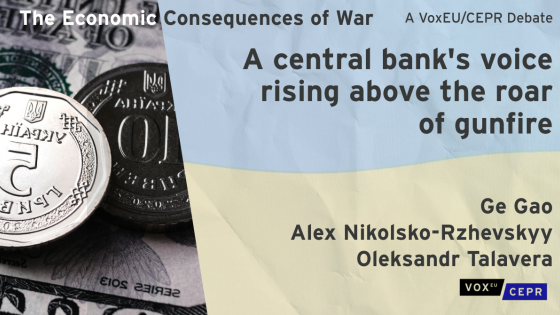The predictability of exchange rates is a crucial question in international finance and macroeconomics. Policy decisions of central banks and policymakers all over the world rely, directly or indirectly, on exchange rate forecasts. The same holds for private business and practitioners' decisions. Discussions in policy circles and forecasting businesses often revolve around the difficult theme of forecasting exchange rates, as the recent discussions about currency wars and international monetary-policy coordination during the recent financial crisis have shown.
Since Meese and Rogoff (1983a,b, 1988), it has been well known that exchange rates are very difficult to predict using economic models. However, the recent literature has identified new predictors and models that claim to forecast exchange rates (Gourinchas and Rey 2007, Mark 1995, and Molodtsova and Papell 2009, among others). Unfortunately, the findings in the literature are sometimes contradictory.1
Researchers trying to forecast exchange rates typically face several choices.
- First, one has to choose a predictor.
There is no shortage of predictors used in the literature: interest rates, output, money supply, trade balance, net foreign asset positions, commodity prices, etc. Are any of these predictors is capable of forecasting future exchange rates better than simply using the exchange rate value today, which is what the random walk would predict?
- Second, one has to choose a model.
Again, there is no shortage of models used in the literature: linear, non-linear, non-parametric, panel, factor, forecast combinations, Bayesian model averaging, etc.
- Third, one has to specify the data for testing.
For example, should one use forecasts based on revised or real-time data. Should they be filtered, de-trended or raw? Which frequency and countries should be considered and at what forecast horizon?
Finally, there is the issue of criteria for forecast evaluation.
Should one use mean squared forecast error, mean absolute errors, utility-based or direction of prediction measures? Should the focus be on in-sample or out-of-sample tests? What about measures of relative or absolute forecasting performance, etc?
Which choices should exchange-rate researchers make?
Faced with these choices, researchers turn to the existing literature for guidance. However, existing papers offer contradictory results, and rely on different predictors, tests, samples or databases. It is possible that such predictors might have lost their forecasting ability, or may not be robust to other databases or samples. In addition, while a predictor might be successful according to one measure of performance, it may not be so according to another.
My recent research provides guidance to researchers navigating the existing literature and a reliable overview of established findings that can be helpful in deciding which predictor to use, which model to estimate, which data to collect, and which forecast evaluation tests to utilize (Rossi 2013).
In addition to providing a critical overview of existing predictors and empirical stylized facts identified in the literature – with particular emphasis on reduced-form models and nominal bilateral exchange rates – the paper illustrates the existing empirical evidence using the most up-to-date data and evaluation techniques in order to answer the question: "Does anything forecast exchange rates?".
Findings
Overall, my analysis of the literature and the data suggests that the answer to the question: "Are exchange rate predictable?" is, "It depends." It depends on the choice of predictor, forecast horizon, sample period, model, and forecast evaluation method.
It is possible to go beyond this and draw some broad conclusions. Predictability is most apparent when one or more of the following hold:
- The predictors are Taylor rule and net foreign assets fundamentals,
- The model is linear, and
- A small number of parameters are estimated.
The toughest benchmark is the random walk without drift.
There is some instability over samples for all models, and there is no systematic pattern across models in terms of which horizons or which sample periods the models predict best. Among the negative findings on which the literature has reached a consensus, typically, PPP and monetary models have no success at short (less than 2-3 year) horizons.
Concluding remarks
My work on exchange-rate predictability should be of interest for several audiences. Economists and researchers in academia will find that the literature review and the empirical investigation provide guidance to navigate the literature, and will be useful for their work. Practitioners and forecasters at Central Banks and private businesses will also be interested in knowing which predictors, models and methodologies are most successful. Policymakers, for whom successful policy decisions crucially depend on successful forecasts, should be interested in where the literature stands. Finally, newspapers' frequent discussions of exchange rate forecasting suggest this literature review would be useful beyond academia and policy circles.
References
Cheung, Y W, M D Chinn and A G Pascual (2005), "Empirical Exchange Rate Models of the Nineties: Are Any Fit to Survive?", Journal of International Money and Finance 24, 1150-1175.
Chen Y C and K S Rogoff (2003), "Commodity Currencies", Journal of International Economics 60, 133-169.
Engel C, N C Mark and K D West (2007), "Exchange Rate Models Are Not as Bad as You Think", in Acemoglu D, K Rogoff and M Woodford (eds.), NBER Macroeconomics Annual 2007, University of Chicago Press, 381-441.
Faust J, J H Rogers and J H Wright (2003), "Exchange Rate Forecasting: the Errors We've Really Made", Journal of International Economics 60(1), 35-59.
Gourinchas, P O and H Rey (2007), "International Financial Adjustment", Journal of Political Economy 115(4), 665-703.
Groen, J J (2005), "Exchange Rate Predictability and Monetary Fundamentals in a Small Multi-Country Panel," Journal of Money, Credit and Banking 37, 495-516.
Kilian, L (1999), "Exchange Rates and Monetary Fundamentals: What Do We Learn From Long-Horizon Regressions?", Journal of Applied Econometrics 14(5).
Mark, N C (1995), "Exchange Rates and Fundamentals: Evidence on Long-Horizon Predictability", The American Economic Review 85(1), 201-218.
Meese, R A and K S Rogoff (1983a), "Empirical Exchange Rate Models of the Seventies: Do They Fit Out of Sample?", Journal of International Economics 14(1-2), 3-24.
Meese, R A and K S Rogoff (1983b), "The Out-of-Sample Failure of Empirical Exchange Rate Models: Sampling Error or Mis-specification?", in JFrenkel, (ed.) Exchange Rates and International Macroeconomics, Chicago: NBER and University of Chicago Press.
Meese, R A and K S Rogoff (1988), "Was it Real? The Exchange Rate-Interest Differential Relation Over the Modern Floating Rate Period", Journal of Finance 43, 923-948.
Molodtsova, T and D H Papell (2009), "Out-of-Sample Exchange Rate Predictability with Taylor Rule Fundamentals", Journal of International Economics, 77(2), 167-180.
Rogoff, K and V Stavrakeva (2008), "The Continuing Puzzle of Short Horizon Exchange Rate Forecasting", NBER Working Paper 14071.
Rossi, B (2005), "Testing Long-Horizon Predictive Ability with High Persistence, and the Meese-Rogoff Puzzle", International Economic Review 46(1), 61-92.
Rossi, B (2006), "Are Exchange Rates Really Random Walks? Some Evidence Robust to Parameter Instability", Macroeconomic Dynamics 10(1), 20-38.
Rossi, B (2013), "Exchange Rate Predictability”, Journal of Economic Literature 51(4), forthcoming.
Wright, J (2008), "Bayesian Model Averaging and Exchange Rate Forecasting", Journal of Econometrics 146, 329-341.
1 See Cheung, Chinn and Pascual (2005), Engel, Mark and West (2007), Faust, Rogers and Wright (2003), Groen (2005), Kilian (1999), Rogoff and Stavrakeva (2008), Rossi (2005, 2006), and Wright (2008), among others.


